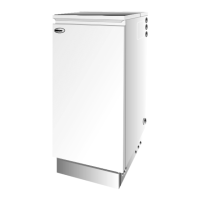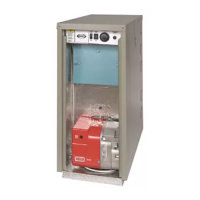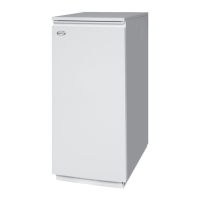36
Grant Vortex Indoor/Utility, System and Boiler House Oil Boilers
It is important that the following commissioning
procedure is carried out to ensure safe and efficient
operation of the boiler.
Note: Check that the baffles are in position and
that the cleaning cover is correctly fitted and a
good seal made.
IMPORTANT:
Check that the turbulators are in position and that
the ends are vertical (see Fig. 26).
Notes: 1. If the 50/70 model is down rated to 15 kW,
the burner air adjuster disc must also be
adjusted to setting B as described overleaf.
See Section 3.3.
2. If the 50/90 models are down rated to 20
or 15 kW, the burner head must also be
changed to a T1 head. See Section 3.3.
1 Check that the water system has been vented (and
pressurised if sealed system) and there are no leaks.
Ensure the flow pipe has been vented.
2 Check that all fuel line valves are open.
3 Remove the plastic burner cover if it was not
previously removed.
4 Connect a combined vent manifold and pressure
gauge to the pressure gauge connection port on the oil
pump. See Fig. 7. Open the vent screw on your vent
manifold to vent the supply while the pump is running.
5 Set the boiler On/Off switch to Off. Check that all
system controls are calling for heat and turn the
boiler thermostat to maximum. Switch on the
electricity supply.
6 Set the boiler On/Off switch to On. The burner fan
should start and the burner should light within
about 12 seconds. If the burner does not light and
the 'Lock-out' reset button lights, wait for about 45
seconds then press the reset button to restart the
ignition process. This procedure may have to be
repeated several times during first lighting.
7 With the burner alight, check the fuel pressure. Refer
to the Technical Information, Section 3.3. Adjust the
pressure if necessary - see Fig. 7. Note that the 'Mains
On' neon lights when the boiler is switched on, but
does not necessarily indicate the burner is firing.
8 Operate the boiler until it reaches normal operating
temperature. Check oil supply/return pipe for leaks,
rectifying where necessary.
9 Check the operation of the boiler thermostat.
Ensure that by turning it anticlockwise it switches
the burner off.
10 With the burner alight, re-check the fuel pressure and
re-adjust if necessary. Turn the boiler off, remove the
pressure gauge and replace the plug in the pump.
11 Having ensured that there are no oil leaks, replace the
burner cover. Ensure the flexible air tube is connected
to the burner (balanced flue models).
12 Relight the boiler and allow it to run for at least 20
minutes.
13 Check the smoke number, if satisfactory check the
CO
2
. Set the CO
2
to the value given in Section 3.3
for the boiler concerned.
Use the hexagonal key supplied to adjust the
burner air damper (see Fig. 22) as required.
Turning the screw anti-clockwise closes the
damper and increases CO
2
level, turning the screw
clockwise opens the damper and reduces CO
2
level.
Re-check the smoke number if the damper has been
moved. Under no circumstances must the smoke
number be above 1.
Note: It is important that the air damper is
correctly set.
14 Check the flue gas temperature.
15 Check that both the boiler overheat and boiler control
thermostat bulbs are correctly located in their
respective pockets. For location of thermostat pockets,
refer to Fig. 12.
Also check the condition of both thermostat capillaries,
i.e. that they are not damaged, broken or kinked, and
that they are not trapped or crushed between any
internal boiler components.
16 Replace the case top.
17 When the boiler has been adjusted and is running
satisfactorily, balance the central heating system by
adjusting the radiator lock shield valves. Start with
the radiator nearest the boiler and adjust the valves
to achieve the required temperature drop across
each radiator. If thermostatic radiator valves have
been installed, check the system by-pass.
18 Switch off the boiler.
19 With the system hot, check again for leaks,
rectifying where necessary. Drain the system while
it is hot to complete the flushing process. Refill and
vent (and pressurise if a sealed system) the system.
20 A suitable central heating system inhibitor must be
added to protect the system against the effect of
corrosion.
21 Replace the front panel - Locate the bottom of the
panel over the fixing tags then push it towards the
boiler to engage the fixing clips.
7 - COMMISSIONING
